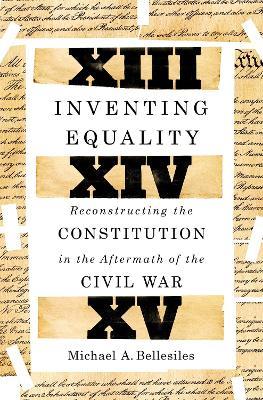Shipping is free

Inventing Equality
Author
Michael Bellesiles
The evolution of the battle for true equality in America seen through the men, ideas, and politics behind the 13th, 14th, and 15th Amendments passed at the end of the Civil War.
On July 4, 1852, Frederick Douglass stood in front of a crowd in Rochester, New York, and asked, What to the slave is the Fourth of July? The audience had invited him to speak on the day celebrating freedom, and had expected him to offer a hopeful message about America; instead, hed offered back to them their own hypocrisy. How could the Constitution defend both freedom and slavery? How could it celebrate liberty with one hand while withdrawing it with another? Theirs was a country which promoted and even celebrated inequality.
From the very beginning, American history can be seen as a battle to reconcile the large gap between Americas stated ideals and the reality of its republic. Its struggle is not one of steady progress toward greater freedom and equality, but rather for every step forward there is a step taken in a different direction. In Inventing Equality, Michael Bellesiles traces the evolution of the battle for true equalitythe stories of those fighting forward, to expand the working definition of what it means to be an American citizenfrom the Revolution through the late nineteenth century. He identifies the systemic flaws in the Constitution, and explores through the role of the Supreme Court and three Constitutional amendmentsthe 13th, 14th, and 15ththe ways in which equality and inequality waxed and waned over the decades.
On July 4, 1852, Frederick Douglass stood in front of a crowd in Rochester, New York, and asked, What to the slave is the Fourth of July? The audience had invited him to speak on the day celebrating freedom, and had expected him to offer a hopeful message about America; instead, hed offered back to them their own hypocrisy. How could the Constitution defend both freedom and slavery? How could it celebrate liberty with one hand while withdrawing it with another? Theirs was a country which promoted and even celebrated inequality.
From the very beginning, American history can be seen as a battle to reconcile the large gap between Americas stated ideals and the reality of its republic. Its struggle is not one of steady progress toward greater freedom and equality, but rather for every step forward there is a step taken in a different direction. In Inventing Equality, Michael Bellesiles traces the evolution of the battle for true equalitythe stories of those fighting forward, to expand the working definition of what it means to be an American citizenfrom the Revolution through the late nineteenth century. He identifies the systemic flaws in the Constitution, and explores through the role of the Supreme Court and three Constitutional amendmentsthe 13th, 14th, and 15ththe ways in which equality and inequality waxed and waned over the decades.
Details
Permanently out of stock
Share